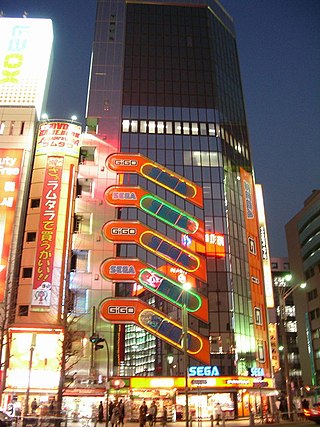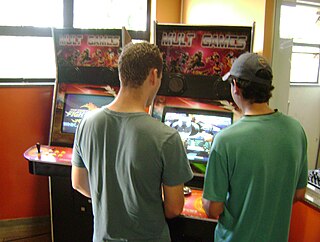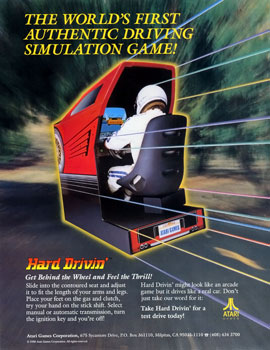
The markka, also known as the Finnish mark, was the currency of Finland from 1860 until 28 February 2002, when it ceased to be legal tender. The markka was divided into 100 pennies, abbreviated as "p". At the point of conversion, the rate was fixed at €1 = 5.94573 mk.

A slot machine, fruit machine, poker machine or pokies is a gambling machine that creates a game of chance for its customers.

Pachinko (パチンコ) is a mechanical game originating in Japan that is used as an arcade game, and much more frequently for gambling. Pachinko fills a niche in Japanese gambling comparable to that of the slot machine in the West as a form of low-stakes, low-strategy gambling.

An amusement arcade, also known as a video arcade, amusements, arcade, or penny arcade, is a venue where people play arcade games, including arcade video games, pinball machines, electro-mechanical games, redemption games, merchandisers, or coin-operated billiards or air hockey tables. In some countries, some types of arcades are also legally permitted to provide gambling machines such as slot machines or pachinko machines. Games are usually housed in cabinets.

WMS Industries, Inc. was an American electronic gaming and amusement manufacturer in Enterprise, Nevada. It was merged into Scientific Games in 2016. WMS's predecessor was the Williams Manufacturing Company, founded in 1943 by Harry E. Williams. However, the company that became WMS Industries was formally founded in 1974 as Williams Electronics, Inc.

An arcade cabinet, also known as an arcade machine or a coin-op cabinet or coin-op machine, is the housing within which an arcade game's electronic hardware resides. Most cabinets designed since the mid-1980s conform to the Japanese Amusement Machine Manufacturers Association (JAMMA) wiring standard. Some include additional connectors for features not included in the standard.

Virtua Racing or V.R. for short, is a Formula One racing video game developed by Sega AM2 and released for arcades in 1992. Virtua Racing was initially a proof-of-concept application for exercising a new 3D graphics platform under development, the "Model 1". The results were so encouraging that Virtua Racing was fully developed into a standalone arcade title.

An electronic game is a game that uses electronics to create an interactive system with which a player can play. Video games are the most common form today, and for this reason the two terms are often used interchangeably. There are other common forms of electronic games, including handheld electronic games, standalone arcade game systems, and exclusively non-visual products.
Illinois Instant Riches is a lottery game show airing in the state of Illinois, as well as nationally on Chicago-based Superstation WGN-TV. The show was hosted by Mark Goodman, with Linda Kollmeyer as his co-host and Bill Barber as announcer.

Hard Drivin' is a sim racing arcade video game developed by Atari Games in 1989. Players test drive a sports car on courses that emphasize stunts and speed. It features one of the first 3D polygon driving environments via a simulator cabinet with a haptic vibrating steering wheel and a custom rendering architecture.
A pay table is the name for the list of payouts on a slot machine or video poker machine. The table shows for each combination of symbols and the number of coins bet how many coins the bettor will win. The pay table feature of the slot machine displays all possible winning sequences for that specific slot game.

A pull-tab is a gambling ticket for a pull-tab game. Other names for the game include Break-Opens, Nevada Tickets, Cherry Bells, Lucky 7s, Pickle Cards, Pickle Tickets, Instant Bingo, Bowl Games, or Popp-Opens.

Jack-Bot is a 1995 pinball game which was designed by Barry Oursler and Larry DeMar, and released by US-based electronic gaming company Williams. It is the third game in the Pin-Bot series, following Pin-Bot (1986) and The Machine: Bride of Pin-Bot (1991).

Prize Bingo is a game derived from standard Bingo games which is particularly popular in UK seaside resorts. Rather than winning cash prizes as per normal bingo, Prize Bingo instead offers points to the winner of each game which can be redeemed in a dedicated shop near to or within the Prize Bingo area although some games reward players with free games or tokens.

Medal games are a type of arcade game commonly found in amusement arcades and casinos, especially in Japan. In order to play a medal game, a customer must first exchange their cash into medals. The rate of medals versus cash varies from arcade to arcade, but usually the cheapest range is from ¥300 all the way up to ¥10,000.

Bingo is a game of probability in which players mark off numbers on cards as the numbers are drawn randomly by a caller, the winner being the first person to mark off all their numbers. Bingo, previously known in the UK as Housey-Housey, became increasingly popular across the UK following the Betting and Gaming Act 1960 with more purpose-built bingo halls opened every year until 2005. Since 2005, bingo halls have seen a marked decline in revenues and the closure of many halls. The number of bingo clubs in Britain has dropped from nearly 600 in 2005 to under 400 as of January 2014. These closures are blamed on high taxes, the smoking ban, and the rise in online gambling, amongst other things.

Slot machine terminology, characteristics and regulations vary around the world.

Dragon's Lair is an interactive film LaserDisc video game developed by Advanced Microcomputer Systems and published by Cinematronics in 1983, as the first game in the Dragon's Lair series. In the game, the protagonist Dirk the Daring is a knight attempting to rescue Princess Daphne from the evil dragon Singe who has locked the princess in the foul wizard Mordroc's castle. It featured animation by ex-Disney animator Don Bluth.

Periscope is an electro-mechanical arcade shooting submarine simulator. Two companies developed similar games with the name. The first, initially called Torpedo Launcher, was designed by Nakamura Manufacturing Co. and released in Japan in 1965, as the first arcade game Masaya Nakamura built. Sega Enterprises, Ltd. also built and released Periscope in Japan in 1966, as one of its first produced arcade games.

An arcade game or coin-op game is a coin-operated entertainment machine typically installed in public businesses such as restaurants, bars and amusement arcades. Most arcade games are presented as primarily games of skill and include arcade video games, pinball machines, electro-mechanical games, redemption games or merchandisers.


















